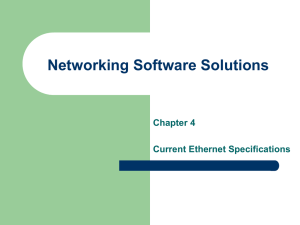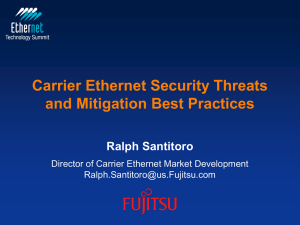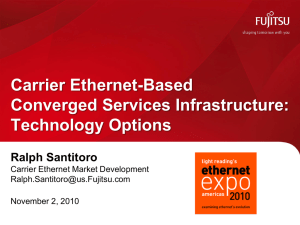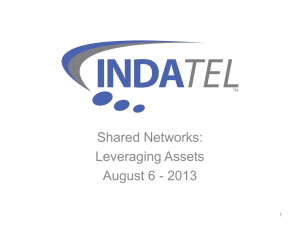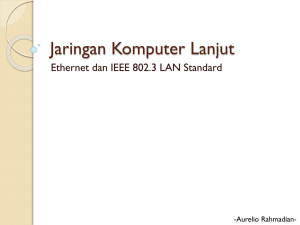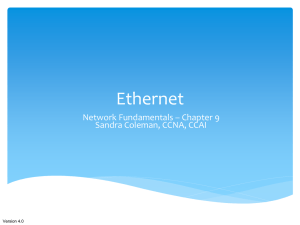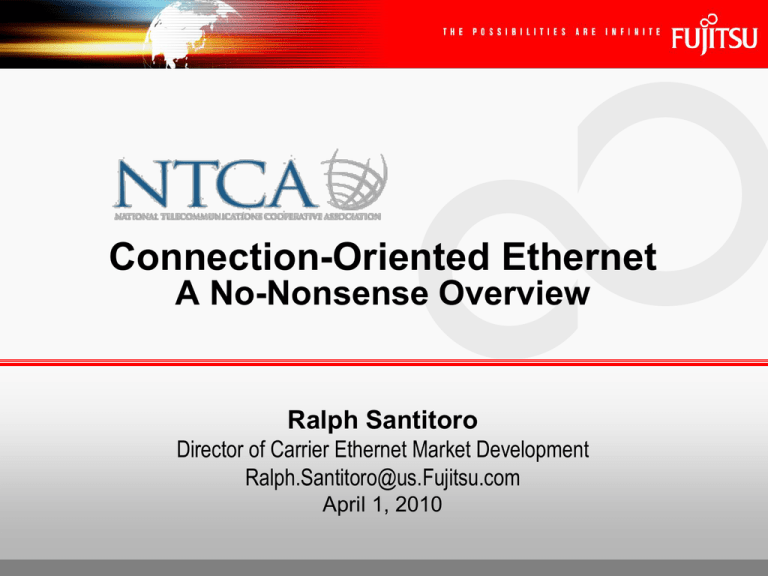
Connection-Oriented Ethernet
A No-Nonsense Overview
Ralph Santitoro
Director of Carrier Ethernet Market Development
Ralph.Santitoro@us.Fujitsu.com
April 1, 2010
Contents
Brief overview of Carrier Ethernet Service Constructs
Different Implementations of Carrier Ethernet
COE Defined
6 Attributes of COE
COE Applications using Packet Optical Networking Platforms
2
© 2010 Fujitsu Network Communications, Inc. All rights reserved.
Connection-Oriented Ethernet: A No-Nonsense Overview
Connection-Oriented Ethernet (COE)
- FAQs
What is COE ?
An industry term that defines a point-to-point implementation of Carrier
Ethernet
What’s the difference between COE and Carrier Ethernet ?
COE is a high performance implementation of Carrier Ethernet
Are COE implementations based on industry standards ?
Yes. Implementations utilize MEF, IEEE, IETF and ITU-T standards
plus value added enhancements where standards are lacking
Fujitsu implementation branded as “Ethernet Tag Switching”
What networking technologies can be used to implement COE?
3
COE can be implemented using Ethernet or MPLS technologies
© 2010 Fujitsu Network Communications, Inc. All rights reserved.
Connection-Oriented Ethernet: A No-Nonsense Overview
Ethernet Service Demarcation
Ethernet User-to-Network Interface (UNI)
Physical Interface and Service demarcation between:
• Retail End-User (Buyer)
• Service Provider (Seller)
Ethernet External Network-to-Network Interface (ENNI)
Physical Interface and Service demarcation between:
• Service Provider Buyer
• Wholesale Service Provider Seller
UNIs and ENNIs provide delineation between
responsibilities of the buyer and seller of a service
4
© 2010 Fujitsu Network Communications, Inc. All rights reserved.
Connection-Oriented Ethernet: A No-Nonsense Overview
Ethernet Service Constructs
Ethernet Virtual Connection (EVC)
Logical association between two or more UNIs
Retail (end-user) service construct
Operator Virtual Connection (OVC)
Logical association between either:
• UNI and ENNI
• ENNI and ENNI
Wholesale (service provider) service construct
EVCs describe Virtual Connectivity for Retail services
OVCs describe Virtual Connectivity for Wholesale services
5
© 2010 Fujitsu Network Communications, Inc. All rights reserved.
Connection-Oriented Ethernet: A No-Nonsense Overview
Putting it all together
Subscriber
Wholesale
Access Provider
OVC1
ENNI
Wholesale
Transport Provider
OVC2 EVC
UNIs at Subscriber Locations
ENNIs between
ENNI
Retail Service
Provider
OVC3
UNI
Subscriber
UNI
Wholesale Access Provider and Wholesale Transport Provider
Wholesale Transport Provider and Retail Service Provider
OVCs between
Subscriber UNI and Wholesale Access Provider ENNI
Wholesale Transport Provider ENNIs
Retail Service Provider ENNI and Subscriber UNI
EVC between Subscriber UNIs
6
© 2010 Fujitsu Network Communications, Inc. All rights reserved.
Connection-Oriented Ethernet: A No-Nonsense Overview
Different Implementations of Carrier Ethernet
Connectionless Ethernet (CLE) and
Connection-Oriented Ethernet (COE)
Connectionless Ethernet (CLE)
When most think of Ethernet, they
think of Ethernet LANs
Technically referred to as Connectionless
Ethernet
Single User per Ethernet Interface
Network is inside a building
LAN
UNI
UNI
CLE is also used in Carrier Networks
8
Subscriber sites connect to an Ethernet UNI
Multiple Users per Ethernet Interface
Network is across a wide area
© 2010 Fujitsu Network Communications, Inc. All rights reserved.
MP2MP
EVC in
Carrier
Network
UNI
UNI
UNI
Connection-Oriented Ethernet: A No-Nonsense Overview
Connectionless Ethernet limiting factors in
Carrier Ethernet networks
Non-Deterministic QoS and Traffic Patterns
Inconsistent Bandwidth for Subscribers
Ethernet MAC Address learning performed periodically through
broadcasting of unknown address to all ports (called flooding)
Flooding takes away from revenue-generating bandwidth
Difficult to Guarantee Bandwidth (Traffic Engineering)
Traffic path highly variable due to spanning tree topology changes
Creates variable QoS performance (Delay, Delay Variation, Loss)
Difficult to troubleshoot variable traffic paths
Multiple ingress and egress points in the network
Difficult to provide High Network Availability
Spanning Tree variants cannot meet demanding service requirements
CLE requires technology augmentation to make it “Carrier Grade”
9
© 2010 Fujitsu Network Communications, Inc. All rights reserved.
Connection-Oriented Ethernet: A No-Nonsense Overview
Connection-Oriented Ethernet (COE)
The best of both worlds
Connectionless Ethernet
• Layer 2 Aggregation
• Statistical Multiplexing
• Flexible Bandwidth Granularity
• Cost Effectiveness
Ethernet over SONET
• Deterministic and precision QoS
• Bandwidth reserved per STS
• 99.999% Availability
• Highest Security (L1 service)
Connection-Oriented
Ethernet
COE makes Ethernet simpler (like a Layer 1 service)
but with all the benefits of Layer 2 Ethernet
10
© 2010 Fujitsu Network Communications, Inc. All rights reserved.
Connection-Oriented Ethernet: A No-Nonsense Overview
Connection-Oriented Ethernet Defined
Carrier Ethernet with Traffic Engineering
ConnectionOriented Ethernet
Connectionless
Ethernet
1. Ethernet frames take
predetermined path
Provisioned by
management system
2. Each Flow is Traffic
Engineered
Bandwidth Reserved
per Flow
11
EVC
EVC
?
Explicit data path
Implicit data path
ConnectionOriented Ethernet
Connectionless
Ethernet
EVC1
EVC2
EVC3
EVC1
EVC2
EVC3
?
Per-flow TE
Aggregation
Deterministic performance
Statistical performance
© 2010 Fujitsu Network Communications, Inc. All rights reserved.
Connection-Oriented Ethernet: A No-Nonsense Overview
COE Supported Network Topologies
for MEF EPL and EVPL Services
Mesh
Linear
Ring
Hub & Spoke
COE supports many topologies used with popular Ethernet services
12
© 2010 Fujitsu Network Communications, Inc. All rights reserved.
Connection-Oriented Ethernet: A No-Nonsense Overview
Why COE ?
Makes Ethernet more like SONET which dominates metro
networks today
Network operations procedures similar to SONET
Smoother transition for SONET-trained operations personnel
Highly scalable packet-centric technology
Meets large scale metro connectivity and aggregation requirements
COE delivered over:
• SONET/SDH, PDH, OTN, WDM, Fiber (native Ethernet)
Ideally suited for:
Metro Ethernet Aggregation for handoff to IP service edge networks
Mobile Backhaul Networks
Commercial Business Services
• Ethernet Private Lines (EPL)
• Ethernet Internet Access
• Layer 2 VPNs (EVPL)
13
© 2010 Fujitsu Network Communications, Inc. All rights reserved.
Connection-Oriented Ethernet: A No-Nonsense Overview
Different approaches to COE
MPLS-centric COE
Static PW
Eth PW
T-MPLS MPLS-TP
MPLS LSP
PW Eth
• Ethernet
• MPLS Pseudowire (PW)
• MPLS Label Switched Path (LSP)
PBB-TE
PBT
Eth
Ethernet Tag
Switching
S-VLAN or PBB-TE Eth
• Ethernet
MPLS-centric COE (Standards under development)
Ethernet-centric COE
Proposed usage for interconnection of P/PE routers in inter-metro core
Ethernet-centric COE (Standards complete)
Now being deployed in metro networks
Ethernet-centric implementations simplify OAM&P
Only 1 layer to manage: Ethernet
14
© 2010 Fujitsu Network Communications, Inc. All rights reserved.
Connection-Oriented Ethernet: A No-Nonsense Overview
Connection-oriented Ethernet Attributes
COE Ecosystem
Attributes of Connection-oriented Ethernet
Standardized Services
• MEF 6.1 Service Definitions
• MEF 10.2 Service Attributes
Deterministic QoS
Scalability
• Lowest Delay, Delay Variation, Loss
• Bandwidth Resource Reservation
• Connection Admission Control
• Layer 2 Aggregation
• Statistical Multiplexing
• Tag Swapping/Reuse
COE
Attributes
Reliability / Availability
Ethernet OAM
• G.8031 50ms EVC Protection
• 802.3ad UNI & ENNI Protection
• 802.3ah Link Fault Management
• Y.1731 Service Fault Management
Security
• No Bridging: MAC DoS attacks mitigated
• Completely Layer 2: No IP vulnerabilities
16
© 2010 Fujitsu Network Communications, Inc. All rights reserved.
Connection-Oriented Ethernet: A No-Nonsense Overview
Standardized Services
COE supports MEF Services using Point-to-Point EVCs
Ethernet Virtual Private Line (EVPL)
Ethernet Private Line (EPL)
COE supports MEF Point-to-Point OVCs
Wholesale Ethernet Access Services
COE supports the MEF UNI and ENNI service attributes
UNI Attributes in MEF 10.1
ENNI and OVC Attributes in MEF 26
COE Supports the Standard MEF Services
and Service Building Blocks
17
© 2010 Fujitsu Network Communications, Inc. All rights reserved.
Connection-Oriented Ethernet: A No-Nonsense Overview
COE provides deterministic QoS
Committed Information Rate (CIR) reserved for each EVC
Bandwidth reserved at each ingress and egress port throughout
network using Connection Admission Control (CAC)
For Working and Protect Paths for a given EVC
Working Path
EVC
Management System
Protect Path
Bandwidth Reserved End-to-End
COE CAC assures requisite bandwidth is reserved
EVC is traffic engineered to achieve QoS Performance Objectives
18
© 2010 Fujitsu Network Communications, Inc. All rights reserved.
Connection-Oriented Ethernet: A No-Nonsense Overview
COE over SONET using VCG Sharing
More Bandwidth Efficient than Ethernet over SONET
Ethernet over SONET (EoS) Challenges
Eth
EoS doesn’t support aggregation
MSPP
Eth
• EoS is a port-based service
• Ethernet switch added for aggregation
Eth
MSPP
PE
Router
MSPP
MSPP
SONET VCG
EoS service bandwidth dictated by SONET
• EoS bandwidth in 50Mbps STS increments
• Other bandwidth rates waste SONET bandwidth
SONET
30Mbps
wasted
50Mbps
20Mbps
COE over SONET with VCG Sharing
COE supports service aggregation
Eth
PONP
Eth
PONP
Eth
PONP
COE
over
SONET
PONP
COE aggregates services on same SONET VCG
50Mbps
PE
Router
20Mbps
10Mbps
20Mbps
COE over SONET with VCG Sharing Improves SONET bandwidth utilization
19
© 2010 Fujitsu Network Communications, Inc. All rights reserved.
Connection-Oriented Ethernet: A No-Nonsense Overview
COE Security: Comparable to SONET
Management VLANs isolated from Subscriber traffic
COE doesn’t use MAC Address Learning / Flooding like CLE
MAC Address spoofing cannot occur
MAC table overflow DOS attacks cannot occur
COE doesn’t use vulnerable Layer 2 Control Protocols (L2CPs)
like CLE’s Spanning Tree
similar to DCN isolation from subscriber traffic in SONET networks
Protocol-based vulnerabilities (DoS/DDoS attacks) are mitigated
COE doesn’t use bridging protocols so ports cannot be mirrored
Traffic snooping cannot occur
COE provides security comparable to Layer 1 (EoSONET)
but with no SONET bandwidth utilization issues
20
© 2010 Fujitsu Network Communications, Inc. All rights reserved.
Connection-Oriented Ethernet: A No-Nonsense Overview
Ethernet OAM for COE
ENNI-N
UNI-N
UNI-C
ENNI-N
Network
Domain 2
Network
Domain 1
UNI-N
UNI-C
Service
OAM
ITU-T Y.1731 End-to-End Performance Monitoring
IEEE 802.1ag End-to-End Connectivity Fault Management
Link
OAM
IEEE 802.3ah
Link OAM
21
Link OAM
© 2010 Fujitsu Network Communications, Inc. All rights reserved.
Link OAM
Connection-Oriented Ethernet: A No-Nonsense Overview
COE Fault Management Comparison
with SONET
Standard
Fault
Management
Comparable to
SONET
ITU-T Y.1731 / IEEE 802.1ag
Tunnel Layer
STS Path / VCG
ITU-T Y.1731 / IEEE 802.1ag
Service (EVC) Layer
VT1.5 or STS Path
IEEE 802.3ah
Link (physical) Layer
SONET Line
FLASHWAVE
CDS
Tunnel OAM
EVC1
EVC2
FLASHWAVE
Service OAM
EVC 1, 2 and 3
FLASHWAVE
CDS
CDS
EVC3
FLASHWAVE
CDS
Link
Link OAM
COE leverages the complete set of Ethernet OAM standards
22
© 2010 Fujitsu Network Communications, Inc. All rights reserved.
Connection-Oriented Ethernet: A No-Nonsense Overview
COE Provides Sub-50ms Ethernet Path
G.8031 Linear Path Protection Standard
Continuity
Check Messages (heartbeats) Monitor EVC health
If CCMs not received from Working Path due to EVC failure
Network Element switches to Protect Path
Working
and Protect Path traffic engineered
to meet EVC performance and bandwidth requirements
Working
Path
Link
Failure
Working Path
Protect
Path
Protect Path
50ms SONET-like protection using Ethernet-based mechanisms
23
© 2010 Fujitsu Network Communications, Inc. All rights reserved.
Connection-Oriented Ethernet: A No-Nonsense Overview
Achieving Highest Reliability
Fujitsu Packet Optical Networking Platforms with COE
Link Protection using IEEE 802.3ad Link Aggregation
In-Service Software Upgrades
Network continues to operate as new software is tested and deployed
Equipment Protection
For local diversity and protection for UNIs and NNIs
Link Aggregation across different cards in a network element
Redundant switch fabric, control processors, etc.
EVC and OVC Path Protection
Path diversity with sub-50ms path protection using ITU-T G.8031
• Similar to SONET UPSR path protection (Working path and Protect path)
Bottom Line: No single point of failure
24
© 2010 Fujitsu Network Communications, Inc. All rights reserved.
Connection-Oriented Ethernet: A No-Nonsense Overview
COE Applications using
Packet Optical Networking Platforms (PONP)
COE for Commercial Business Ethernet Services
COE-based Ethernet Service
Retail Service
Retail EVPL Services
IP Service Site-to-Site Provider Partner
network
Networks COE EVPL
Site-to-Cloud Service
• COE between
• End User
• IP Service Networks
PE
UNI
Site-to-Site Service
• COE between End Users
PE
Metro
Network
Site-to-Cloud PONP
COE EVPL
Wholesale Ethernet Access
Service
Site-to-Cloud Service
• COE between:
• End User
• Retail Service Provider Partner
ENNI
PONP
Site-to-Cloud
COE EVPL
UNIs
PONP
PONP
End User(s)
Packet-Optical Networking Platforms (PONP) with COE deliver retail and
wholesale Ethernet services with SONET-like reliability and security
26
© 2010 Fujitsu Network Communications, Inc. All rights reserved.
Connection-Oriented Ethernet: A No-Nonsense Overview
Mobile Backhaul Evolution
From SONET to Ethernet using COE
Cell tower MSC
PMO:
SONET
MSPP at MSC
FMO Step 1:
Add PONP using COE
over SONET to increase
bandwidth efficiency
Packet ONP (PONP)
at MSC
SONET
MSPP
at Cell Site
TDM
T1s
EoS
Ethernet
2G/3G 3G/LTE
SONET
PONP at Cell Site
FMO Step 2:
Begin Migration to Ethernet
over Fiber (EoF) network
Existing services unaffected
Packet ONP at MSC
SONET
EoF
PONP at Cell Site
µPacket ONP
TDM
T1s
COE
Ethernet
2G/3G 3G/LTE
TDM
T1s
COE
Ethernet
2G/3G 3G/LTE
Packet-Optical Networking Platforms (PONP) with COE facilitate
MBH network migration of multi-generation 2G/3G/LTE services
27
© 2010 Fujitsu Network Communications, Inc. All rights reserved.
Connection-Oriented Ethernet: A No-Nonsense Overview
Why Connection-Oriented Ethernet
for Mobile Backhaul ?
Meets MBH functional requirements set forth by SONET
Deterministic performance
Service OAM
Guaranteed bandwidth
Highest network availability
Simpler Network OAM – just one Ethernet layer to manage
Consistent with existing SONET-based network operations
No IP knowledge required
Simpler to learn by SONET transport staff
Provisioning model similar to SONET
COE meets the high performance demands
of mobile backhaul networks
28
© 2010 Fujitsu Network Communications, Inc. All rights reserved.
Connection-Oriented Ethernet: A No-Nonsense Overview
DSL Backhaul Evolution
From ATM/SONET to Ethernet using COE
OSP Cabinet CO
PMO:
SONET
MSPP at CO
FMO Step 1:
Add PONP using COE
over SONET to increase
bandwidth efficiency
FMO Step 2:
Begin Migration to Ethernet
over Fiber (EoF) network
Existing services unaffected
Packet ONP (PONP)
at CO
Packet ONP at CO
SONET
SONET
MSPP at OSP
PONP at OSP
SONET
EoF
PONP at OSP
µPacket ONP
TDM
EoS
DS3/OC3
Ethernet
ATM
DSLAM
IP
DSPLAM
TDM
COE
DS3/OC3
Ethernet
ATM
DSLAM
IP
DSPLAM
TDM
DS3/OC3
ATM
DSLAM
COE
Ethernet
IP
DSLAM
Packet-Optical Networking Platforms (PONP) with COE facilitate
DSL-Backhaul migration from Legacy ATM to IP DSLAMs
29
© 2010 Fujitsu Network Communications, Inc. All rights reserved.
Connection-Oriented Ethernet: A No-Nonsense Overview
Summary
Connection-Oriented Ethernet (COE)
Is a high performance implementation of Carrier Ethernet
Supports Standard MEF EVPL, EPL and Ethernet access to IP services
Provides Layer 1 SONET-like Security benefits
COE over SONET on Fujitsu’s Packet Optical Networking Platforms
Significantly improves bandwidth utilization over existing SONET networks
For more information on
Connection-Oriented Ethernet and Fujitsu’s FLASHWAVE
Packet Optical Networking Solutions, visit
us.Fujitsu.com/Telecom
30
© 2010 Fujitsu Network Communications, Inc. All rights reserved.
Connection-Oriented Ethernet: A No-Nonsense Overview
Questions ?

